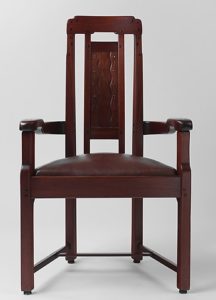The Arts & Crafts and Native American Connection
For several decades, Arts and Crafts collectors have paired their furniture with Native American baskets, blankets, and beadwork. You may ask yourself, what is the common link that connects these two categories of collecting?

The Gamble House
Let’s begin with Charles Sumner Greene and Henry Mather Greene, renowned American Arts and Crafts architects. Greene and Greene are most famously known for building the Gamble House. Not only would the brothers draft plans for the house itself, but they would also design furniture, lighting and sometimes even the garden or landscape. Greene and Greene are generally known to have been influenced by Japanese art. In the early 1900s when Greene and Greene were beginning their studies, exhibitions on the newly opened Asian country were quite popular. The Museum of Fine Art had a major collection of Japanese art, and there were also Japanese art exhibits at the 1904 Louisiana Purchase Exhibition in St. Louis. One can clearly see the influence that Japanese art had on the brothers, from the stained glass lantern light fixtures that fill their California homes, to the construction of their porches. Many of the homes built by the brothers have aspects that were borrowed from Japanese temples including doorways.
So how did Arts and Crafts collectors come to love Native American art?

One of six shades from the Blacker House in Pasadena, now in the Metropolitan Museum of Art collection.
The answer lies, not in the particular regions that so greatly guided the acclaimed architects and furniture makers, but rather, in the ideology of the movement itself. The Arts and Crafts movement was a revolt against the Industrial Age and machine made furniture. In stark contrast to the assembly line mentality, the Arts and Crafts movement prized craftsmanship and utilizing local materials. Throughout Greene and Greene homes, the detail work and craftsmanship is evident. From the pegged construction of the joinery to the illustrative stained glass fixtures, it is apparent that the architects valued fine hand elaborated details. This quality is clearly executed in the Greene and Greene pieces in the Metropolitan Museum of Art collection.
The movement emphasized a connection between the indoor and outdoor lifestyle, prizing a simpler and slower way of life, as opposed to the chaotic Industrial age. The local materials used in Greene and Greene architecture highlight this, and as Bruce Smith so eloquently states:
“the Greene houses always seem to cling to the earth… Each material integrates the house to its surroundings and leads to the next, from coarseness outside to sublimity inside” (Smith, 32).
The value of craftsmanship and use of local materials is most apparent in Charles Greene’s James House, on the Carmel coast, which Charles began work on in 1918. It took Charles a year to build the foundation and retaining walls, which utilized rock from directly off of the coast (for more information on the James House, check out Greene and Greene Masterworks by Bruce Smith). The Greenes also built with other local materials including Port Orford cedar and redwood.

Dining room armchair for the Blacker House, Honduras mahogany, ebony, fruitwood, silver, copper, and mother of pearl, now in the MET collection
It is here that the connection to Native American art is discovered.
As with decorative art and furniture from the Arts and Crafts period, it is evident that Native Americans have always valued handcrafted beauty as even early containers often were hand decorated. Additionally, over the course of history, local materials have been used throughout Native American art. The Navajo would spin wool by hand from their flocks of sheep, and often used natural and vegetal dies throughout their basketry and blankets. Baskets are the earliest form of vessel created by Native Americans, and basketry was used for a variety of purposes including hats, clothing, storage containers, etc.
Each region uses different patterns and materials. The materials used to create Native American baskets were generally locally available (and this can help identify that a basket is from a particular group of people). For example, Tlingit often employ cedar bark and spruce root, while Northern California baskets might use pine root and willow. Pomo baskets are sometimes decorated with feathers including mallards and quails (feathered baskets have been found at archaeological sites). It is apparent that craftsmanship is prized and valued in Native American art, with local weaving traditions passed down through the generations. To learn more about collecting Navajo blankets, check out our earlier blog post.
It is clear that Native American and Arts and Crafts collectors both share a strong appreciation for fine handcrafted art, attention to detail, and local materials
Reference:
Smith, Bruce, and Alexander Vertikoff. Greene & Greene: Masterworks. Archetype Press, 1998.
